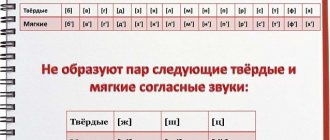Most often, dysgraphia occurs in younger schoolchildren. However, pathology may well develop in adults. Approximately 10% of all cases of writing disorders occur in adulthood as a result of various factors that impair mental functioning.
What causes missing letters in a letter?
- speech therapy reason - difficulties with pronunciation and perception of certain sounds;
- poor concentration;
- undeveloped self-control skill;
- poor vocabulary;
- low performance
Speech therapy reason
If a child does not pronounce some sounds, then I, of course, highly recommend seeking help from a speech therapist. But, in addition to the exercises recommended by a specialist, parents can provide invaluable help to their child if they perform the following types of tasks in the form of a game:
- isolating the first or last sound from a word;
- the presence (is, is not) of a given sound in a word;
- determining the place of a sound (beginning, middle, end) in a word;
- inventing words with a given sound;
- inventing words with a given sound in a given place (at the beginning of the word, middle, end);
- composing chains of words, naming the word based on the last sound of the spoken word;
- transforming words by replacing, rearranging or adding new sounds (lac-bow, rose-thunderstorm, saw-linden);
- counting sounds in a word. You tell the child a word and ask him to say how many sounds it contains. And it’s better if you know the phonetic analysis of a word, then how many letters and sounds are in the word.
Poor concentration
The development of a child’s attention in preschool and primary school age needs to be constantly addressed. There are many different techniques for this:
- Invite your child to copy down non-existent words without errors;
- cross out or underline the specified letter or letters in the text (2-4);
- write small dictations where the child writes only vowels or only consonants;
- write visual dictations;
- divide written texts into separate words;
- write a given letter in block letters, etc.
You can also use various games to develop attention.
Undeveloped self-control skills
The following exercise will help you assess what needs to be developed more in your baby, attention or self-control skills.
Writing words or sentences with your eyes closed.
- Prepare a landscape sheet. Dictate 5-6 words of 4-8 letters to your child. You can dictate 3 sentences of 4-5 words each.
- Take another sheet and do the same, but this time let the child write with his eyes closed.
The writing speed will be slow. This is fine.
There is no need to evaluate the evenness of a line, the space between words, the break of a word, or the partial overlap of letters on each other. Ignore spelling errors due to ignorance of any rules.
Self-control is weak if the number of errors is greater than in similar sentences written under dictation with open eyes.
Teach your child to slowly reread what he has written each time. Read not the way the sound of this word remains in his memory, but exactly the way it is written. If this is cheating, then it is mandatory to compare the written words with the original recording.
Poor vocabulary
If a child hears a word for the first time, the likelihood of spelling it incorrectly increases several times. Therefore, tell your child as much as possible, read with him, develop the baby’s speech, his curiosity, constantly communicate with your child as much as possible.
Many children, unfortunately, entering first grade do not have basic knowledge about themselves and the world around them. And this, of course, is primarily the fault of the parents. It is more difficult for such children to study; they experience discomfort watching their more erudite classmates. I advise you to familiarize yourself with what a child should know by first grade.
Low performance
We are all different. Also, naturally, some children are diligent, and some are not at all. But you can always find a way to motivate a child, explain to him and convince him of the need for this or that action. Be sure to create a situation of success for your children. And, of course, exclude all distractions: conversations, extraneous noise, TV, etc. And we remember that the performance of a child differs from the performance of an adult. This quality develops over time.
Special exercises in the form of exciting games help the child, and even completely solve this problem
Why does dysgraphia occur in adults?
The impetus for the development of written language disorders in adults can be many external and internal factors. Having a negative impact on the functioning of brain structures, such factors cause dysgraphia and other mental dysfunctions.
Among the main reasons causing problems with correct writing in adults, experts identify:
- head injuries;
- neurosurgical operations;
- proliferation of brain tumors;
- infectious brain damage (meningococcal infections);
- inflammatory processes affecting the brain (meningitis);
- strokes;
- trauma during childbirth;
- appropriate social conditions;
- insufficient blood oxygen saturation (asphyxia).
Learning not to skip letters
You can help your child overcome difficulties in mastering competent written speech on your own. To do this, you need to play, and not write exhausting dictations.
The presented games and tasks help to set up work, activate control functions, train attention switching, and develop the functions of block III of the brain (programming, control, serial organization of movements). ⠀
These tasks do not have to be completed every day. But by training your child in this playful way, performing 4-5 exercises daily, you will definitely get noticeable results in just two weeks. And help your student believe in himself!
Source
Work on dysgraphia correction with a speech therapist
Any doctor will tell you that self-medication is unacceptable, and this is true.
Basically, a speech therapist works with dysgraphia, but a neuropsychologist, a psychotherapist, and an educational psychologist can also work.
You should prepare for the fact that the process of eliminating speech and writing disorders will not be quick. The correction program is built depending on the causes, type of violation and age characteristics. The older he is, the more difficult it is to carry out the correction.
Handwriting correction.
The fact is that for a child with dysgraphia, handwriting causes a certain difficulty. Typically, such children write either very small or extremely large. Sloppy handwriting is not a negative thing, and you shouldn’t scold a child for it.
It will take about three weeks to teach a student to write correctly. First, you need to purchase a squared notebook and ask to reproduce the text on paper. The letter should not go beyond the cell - the main rule. You need to monitor this and support the child in every possible way.
You cannot overload children; a few correctly written lines a day are an excellent result. Even if parents are tired of working with their child, it is strictly forbidden to show it, much less raise their tone. It is recommended to use pens with a ribbed surface as writing instruments, as well as pencils in the shape of a triangle.
At home, you can play with your child by giving him a pen and ink. Then he will try to write correctly so as not to spoil the game.
Detection of dysgraphia in adults
Treatment of writing disorders in adults, as well as in children, begins with a specialist studying written work done using special techniques. First of all, the speech therapist needs to determine whether writing defects are a manifestation of dysgraphia, or are the result of a person’s illiteracy. The subject performs a number of written tasks, including:
- copying text material (printed and handwritten);
- writing a dictation;
- writing descriptions for pictures;
- reading a whole text, as well as individual words and separate syllables.
During the diagnosis, the state of oral speech is also studied, which includes:
- assessment of the correct pronunciation of sounds;
- vocabulary learning;
- analysis of skills to identify sounds by ear.
After conducting the necessary tests, the speech therapist analyzes the errors, identifying among them those that are typical for certain types of dysgraphia. Next, a speech therapy report is drawn up. If the diagnosis is confirmed, further correction of the defect is required.
EXERCISE 8.
This is the game "Count the letters". The student names each letter by number in the word. An adult dictates 2 words each, for example “catfish” and “cat”. The child’s task is to name the third letter. You can complicate the task and dictate 2 words of 4 letters, for example “elephant” and “mole”. With the help of the exercise, the student will learn to mentally reproduce and write words correctly, and he will also remember their lexical meanings. The presented exercises are also aimed at developing concentration. If a student does them regularly, he will be able to learn to retain the letter structure of words in his thoughts. To fully master a language, children must feel the images of words. You should know that some words have the same root. Most often, students miss letters when they do not know what the words stand for. Another possible reason is poor concentration. Thus, the student cannot determine what exactly is misspelled in the word. Or perhaps the child’s imagination is so developed that when he hears words, he immediately draws images of them in his thoughts. Then there is no symbolic, literal designation of an object (concept, phenomenon).
Exercises to correct dysgraphia at home
Is it possible to correct and how to correct dysgraphia at home? Yes, after consultation with a speech therapist and his analysis of the situation, the main burden falls on doing the exercises at home. Below are exercises for correction. You can apply them and practice them yourself. This way you will not only help the correction, but also get closer to your baby.
"Labyrinth"
You need to go through the labyrinth by drawing a continuous line on a piece of paper without lifting your hand or turning the labyrinth.
Graphic dictations
These are tasks in which you need to draw something on a checkered sheet of paper based on prompts. There are graphic dictations in which a letter or number must be obtained.
Construction of signs from elements
You can make letters and numbers from different objects: counting sticks, pencils, cereals, plasticine, and so on. You can draw drawings on paper in the form of signs. From already composed symbols, you can recompose them. Take them apart and put them back together.
Schulte tables
Schulte tables, the Munstenberg technique and other psychological methods for developing attention related to numbers. According to psychologists, this is especially effective when the child is between 10 and 11 years old.
Crosswords
Scanwords, crosswords, English crosswords, Sudoku and other puzzles.
Recognizing incomplete notations
Play recognizing letters and numbers that are not fully drawn. Let the child add the part of the sign that is missing. Some designs can be continued into several different symbols. For example, the letter “B” and the number “5” have a common part.
Finding missing letters in a word
Write a word and deliberately leave out a letter or even a syllable. Let the student analyze the word, find gaps, highlight the syllable, correct the mistake and name the correct spelling.
Memorizing poems
This is also a kind of exercise that develops memory and speech. In our case, poetry will help us gain a sense of rhythm in speech.
Play with words
Make anagrams: rearrange letters and syllables in words so that they form new words or phrases. You can also take some medium or large word and try to make words from the letters in it. There are a lot of similar techniques.
Development of fine motor skills
It seems that everyone around is already repeating this: the development of speech is associated with fine motor skills. Make the most of this opportunity: let the child’s psyche take a break from the Russian language, and let him take up modeling, beads, construction sets, origami and other interesting activities. Turn on your imagination - and you will succeed. In addition, it will be extremely interesting for both you and the child!
Psychological comfort when writing
You must provide your pupil, first of all, with psychological comfort, because without it the problem will either not be solved, or will be solved, but with consequences of a different nature. Fear of the teacher, hatred of writing and lessons, shame in front of classmates and more.
- Talk to teachers. Explain the seriousness of the situation and ask them to behave competently. Let them not focus the attention of other children on the problem and be patient. The teacher's duty is to treat his student with understanding. This means helping, stopping the ridicule of others and not scolding for mistakes. A teacher who does not understand this can not only interfere with the correction of dysgraphia, but also lead the student to nervous overstrain. Just imagine the situation. You are a small child of 8 years old who cannot do what all girls and boys do with ease. At the same time, an adult, a teacher with whom you often have contact, scolds you for writing mistakes, and meanwhile your peers ridicule them. And this continues for quite a long time, day after day. I think it is obvious that the little person will have neither educational motivation, nor trust in others, nor healthy self-esteem.
- Charge your child only with positive energy. Praise your child for successes more often and do not talk about bad things. It is very important that he believes in himself and does not give up, that is, does not stop doing writing exercises just because he is tired or something does not work out. At the same time, do not force him to overwork: everything should be in moderation. Otherwise, breakdowns cannot be avoided. Remember that parents are the most important thing your son or daughter has. They are his best friends and the closest people in his life. Who, if not you, will support your child in achieving success?
Treatment of dysgraphia
It is better not to try to cope with all problems at once. You need to choose one and focus on it. For example, a child confuses b-p, d-t, and also confuses prepositions with prefixes. If you take on everything at once, the amount of work can be daunting. But if you try to cope only with b-p, and then draw the student’s attention to the fact that, they say, there are fewer mistakes, then you can awaken enthusiasm. And the struggle for universal literacy will continue to be much more fun.
A speech therapist at the clinic will be able to, with a timely visit (at three years old, at five years old and before school itself), determine whether there are any speech therapy problems that will later result in dysgraphia, and, if necessary, recommend special classes. The speech therapist may be joined by a neuropsychologist and a neuropathologist.
I often see very sad children at receptions. They frown when they are asked to write a dictation and immediately admit that they are “bad students.” Then, to cheer them up, I begin to remember various famous people who were also not friends with writing and reading. Maybe a modern child will not be interested in learning that Sergei Rachmaninov, Nikola Tesla, Albert Einstein, most likely, were also dysgraphic, but I think almost any boy will be touched by the information that the great Neo, the winner of the terrible Agent Smiths from The Matrix ”, also had difficulty coping with letters and words in childhood. Well, or rather, actor Keanu Reeves. I usually tell girls about Agatha Christie. Despite the fact that the creator of Poirot and Miss Marple studied poorly and wrote with errors, she became a famous writer. The main thing is to believe in yourself.
Impaired written speech in a child - how to deal with it?
Yana Polya speech therapist of the highest category
When oral speech suffers, everything is clear, a speech therapist is required. When written language suffers, it is required. What? Severe punishment for lack of diligence? Or “you just need to teach better,” as liberal-minded parents say?
Sometimes it’s “better to teach.” And sometimes - both to teach and to heal a little. And in general, you will have to turn to a speech therapist (yes, and with written speech too) so that he can figure out whether emergency speech therapy help is needed. Some parents are very surprised when the school advises them to check with a speech therapist. And they are even more surprised when the speech therapist advises to work out. And under no circumstances should you use a belt or other medieval methods of influencing a person. The speech therapist also says the word dysgraphia, which means a disorder of written speech.
How does dysgraphia manifest in adults?
Violations of written speech have quite characteristic manifestations. A person with dysgraphia makes quite typical mistakes when writing words and sentences. Errors are persistent and typical and are repeated every time the information is transmitted in writing. It is quite important that an adult knows the rules of grammar and spelling well.
Dysgraphia in adults manifests itself in the form of classic errors, such as:
- replacing or mixing letters with similar spellings (for example, Ш and Ш, Л and П, ъ and ь);
- substitution when writing letters that sound similar (p and b, k and x);
- violation of unity or separation when writing individual words;
- incorrect agreement of words in a sentence;
- writing letters too slowly;
- distortion of the arrangement of letters, syllables, their incorrect placement or omission;
- unclear handwriting (unequal height of letters, different inclination of characters, inappropriate writing of large and small characters, etc.).
In addition to the indicated manifestations, experts also identify characteristic symptoms not related to writing, which include:
- neurological abnormalities;
- cognitive disorders;
- difficulties with perception of information;
- memory impairment;
- easy distractibility;
- deviations in motor skills;
- reduced performance;
- temporary or spatial disorientation.
These manifestations are evidence of disruption of connections between brain regions. It should be borne in mind that dysgraphia does not in any way affect the level of intelligence or the quality of a person’s education.
These symptoms will not go away on their own. Targeted training and systematic work on the correction of dysgraphia are necessary.







